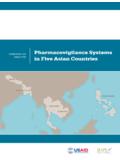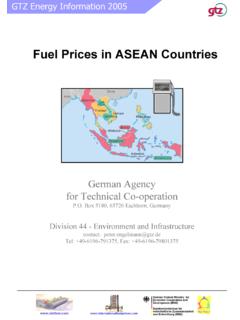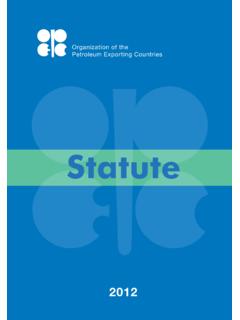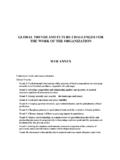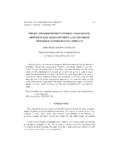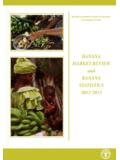Transcription of Inflation Determination in Open Economy Phillips Curve
1 CDE April 2009 Determination of Inflation in an open Economy Phillips Curve Framework: The Case of Developed and Developing asian countries Pami Dua Email: Department of Economics Delhi School of Economics University of Delhi Upasna Gaur Global Research Group, ICICI Bank Mumbai Working Paper No. 178 Centre for Development Economics Department of Economics, Delhi School of Economics Determination of Inflation in an open Economy Phillips Curve Framework: The Case of Developed and Developing asian countries Pami Dua1 Department of Economics Delhi School of Economics University of Delhi, Delhi 110007 and Upasna Gaur Global Research Group, ICICI Bank Mumbai April 2009 Abstract This paper investigates the Determination of Inflation in the framework of an open Economy forward-looking as well as conventional backward-looking Phillips Curve for eight asian countries - Japan, Hong Kong, Korea, Singapore, Philippines, Thailand, China Mainland and India.
2 Using quarterly data from the 1990s to 2005 and applying the instrumental variables estimation technique, we find that the output gap is significant in explaining the Inflation rate in almost all the countries . Furthermore, at least one measure of international competitiveness has a statistically significant influence on Inflation in all the countries . The differences in the developed and developing world are highlighted by the significance of agriculture related supply shocks in determining Inflation in the case of developing countries . For all countries , the forward-looking Phillips Curve provides a better fit compared to the backward looking variant. Acknowledgments Earlier versions of this paper were presented at the Project LINK Meeting in October 2006 at United Nations, Geneva; at IGIDR, Mumbai in the 10th Annual Conference on Money and Finance in January, 2008 and at the Conference on Growth and Macroeconomic Issues and Challenges in India at the Institute of Economic Growth in February, 2008.
3 The authors are grateful to the participants of these meetings for useful comments. 1 Corresponding author, e-mail address: 11. Introduction The asian continent is the most diverse region in the world which, on the one hand, has one of the most developed countries in the world, viz. Japan, and while on the other, has several least developed countries , such as Nepal, Afghanistan, Bangladesh and Bhutan. The newly industrialized countries and emerging economies in transition also form part of this region. Most of the asian emerging economies have sustained high and rapid economic growth in the past one or two decades leading to moderate to high Inflation . Inflation has thus become an important concern for the emerging economies. The dynamics of Inflation can be explained in two ways. One school of thought believes that Inflation is largely influenced by non-monetary factors such as supply shocks, which somewhat obscures the role of demand side factors and hence the monetary transmission mechanism in the Inflation process.
4 The other school of thought argues that non-monetary factors affect only the short-run path of Inflation while in the long-run, monetary variables determine the Inflation rate. As a result, it is argued that the standard output gap model of the Phillips Curve should offer a reasonable explanation of the Inflation dynamics in emerging market economies. However, given the diversity amongst nations in Asia, Inflation should be treated as a country-specific phenomenon, the determinants of which would differ across countries . Thus, it is crucial to investigate the plausible distinct factors that determine Inflation in various nations. Against this backdrop, we attempt to empirically determine the factors affecting Inflation in an open Economy Phillips Curve framework for eight asian countries - Japan, Korea, Hong Kong, Singapore, Philippines, Thailand, China, and India.
5 These countries contribute about 80% of the total asian GDP as shown in Table 1. The region-wise share of each of these countries is shown in Table 2. Each nation is characterized by diverse socio-economic conditions. For instance, the share of agriculture in GDP ranges from in Hong Kong in 2005 to approximately 20% in India. The share of labor force employed in agriculture also varies from in Singapore in 2005 to 56% in India. Further, the share of imports in GDP also range from as low as 11% in Japan in 2005 to as high as 188% in Philippines (see Tables 4 and 5). Despite their diverse characteristics, we can broadly classify them on the basis of different stages of development as developed (major industrialized Economy or newly industrialized Economy ) or developing economies (Table 2). 2In order to determine the drivers of Inflation in an open Economy setup, we investigate the importance of the demand and supply side measures for each of these eight asian countries .
6 We also analyze whether the estimated relationship should be forward looking with the expected Inflation rate included as an independent variable, or backward looking. Several studies have been conducted for the developed economies ( Fuhrer and Moore, 1995; Gali and Gertler, 1999; Batini et. al, 2000; Rudd and Whelan, 2005) that focus on a forward looking Phillips Curve . This paper evaluates the possibility of a forward looking Phillips Curve for the developing nations as well. The remainder of the paper is structured as follows. The next section provides the theoretical framework that is applied to our study and the plausible determinants of Inflation . Section 3 provides the data and methodology used in our study. Section 4 presents the estimation results. Section 5 gives the conclusions of our study. 2. The Model Since the focus of the paper is on the Determination of Inflation within the framework of a Phillips Curve , the ensuing discussion briefly describes the theoretical foundations of the Phillips Curve .
7 The traditional Phillips Curve , which provided empirical evidence of a trade-off between unemployment gap and wage Inflation , has undergone considerable modifications. Theoretical foundations of the new Phillips Curve emphasize the role of expectations. Specifically, the New Keynesian Phillips Curve (NKPC) incorporates forward looking behaviour of Inflation (see Fuhrer and Moore, 1995; Roberts, 1995; Fuhrer, 1997; Yun, 1996; Goodfriend and King, 1997; Clarida et al., 1999; Gali and Gertler, 1999; Batini et al., 2000; Svensson (2000); Jensen, 2002; Mankiw and Reis, 2002; Woodford, 2003; Gali, Gertler and Lopez-Salido, 2005; Rudd, J. and Whelan K., 2005). The new Phillips Curve follows the staggered contract model of Taylor2 (1980) and Calvo (1983) with sticky nominal wages and prices in a set-up with forward-looking agents.
8 According to the NKPC analysis, the agents optimize rationally their wage-setting and price-making decision inter-temporally. However, there are nominal rigidities within the Economy that do not allow them to adjust wages and prices immediately as shocks occur. These rigidities give rise to the trade-off between Inflation and excess demand in the short run, which in turn opens a channel through which monetary policy can affect real variables. 2 In Taylor (1980), the staggered price adjustment process is deterministic, while in Calvo (1983) the staggered price adjustment behaviour is stochastic. 3 Following the NKPC model, the framework for examining Inflation in the context of a general backward looking Phillips Curve takes the form: ===== ++++++=ninitnitinitititinititTZXD111111 (1) Likewise, the framework for examining Inflation in the context of a general forward looking Phillips Curve is as follows (2) ====+++++++=ninitnitinititititttTZXDE111 11][ where denotes Inflation rate, E is the expectations operator, D denotes domestic demand side factors, X represents external demand side factors, Z represents domestic supply side factors and T represents external supply side factors.
9 Depending on the specific stage of development, countries have varying characteristics which can impact Inflation . While we do not cover an exhaustive list of determinants3, we do attempt to include factors which are potentially important in determining Inflation in an open Economy framework. These can be broadly divided into the following categories: Demand factors: Demand factors can be further sub-divided into domestic and external factors. Domestic factors (D) In the case of most Phillips Curve models for developed countries , the output gap has been applied as an indicator of demand. The link between interest rate and excess demand is found to be strong in the case of developed economies because of which the transmission mechanism from monetary policy to the real Economy (via the interest rate) is expected to be effective. It has therefore been argued that money should not be included in the Phillips Curve along with output gap since the impact of money on aggregate demand is captured through its effect on the interest rate (Scheibe and Vines, 2005).
10 Output gap models of Inflation , however, have been less commonly applied in the case of developing countries . Coe and 3 Mohanty and Klau (2001) discuss in detail the literature available on the possible determinants of Inflation in case of emerging economies. 4 McDermott (1997) in a study of the output gap model in Asia found that this model did not work well for Thailand, China and India. One explanation for this is that developing countries have relatively underdeveloped financial markets, and therefore a weak relationship exists between interest rates and aggregate demand. Hence, for developing countries , the real money gap can be taken as a potential determinant of Inflation in addition or in lieu of the output gap. In this study, domestic demand factors are therefore captured both by the output gap and the real money gap.

